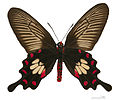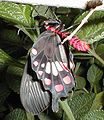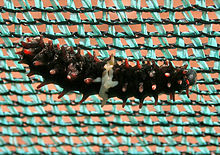- Atrophaneura aristolochiae
-
Common Rose 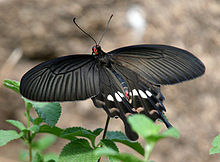
Common Rose in Hyderabad, India Scientific classification Kingdom: Animalia Phylum: Arthropoda Class: Insecta Order: Lepidoptera Family: Papilionidae Genus: Atrophaneura Subgenus: Pachliopta Species: A. (P.) aristolochiae Binomial name Atrophaneura (Pachliopta) aristolochiae
(Fabricius, 1775)The Common Rose (Atrophaneura (Pachliopta) aristolochiae) is a swallowtail butterfly belonging to the Pachliopta subgenus, the Roses, of the genus Atrophaneura or Red-bodied Swallowtails. It is a common butterfly which is extensively distributed across South and South East Asia.
Contents
Range
It is widely distributed in Asia. Afghanistan, Pakistan, India(includes Andaman islands) , Nepal, Sri Lanka, Myanmar, Thailand, Japan (south-western Okinawa only), Laos, Vietnam, Kampuchea(now Cambodia), Nicobar islands, peninsular and eastern Malaysia, Brunei, Philippines (Palawan and Leyte), Indonesia, and Taiwan.
In China, it is distributed in southern and eastern China (including Hainan, Guangdong province), and Hong Kong. In Indonesia, it is distributed in Sumatra, Nias, Enggano, Bangka, Java, Bali, Kangean, Lombok, Sumbawa, Sumba, Flores, Tanahjampea, and Kalimantan.
It is also recorded from Pune.
Status
Very common almost all over the plains of India, and not threatened as a species. Extremely abundant during and after the monsoon.
Description
The upperside of male is velvety black.
Forewing with well-marked pale adnervular streaks on the discal area that do not reach the terminal margin, the latter broadly velvety black; the streaks beyond end of cell extended inwards into its apex.
Hind wing with elongate white discal markings in interspaces 2–5 beyond the cell.
In dry-weather specimens these markings are very short and do not nearly reach the bases of the interspaces; beyond these a curved series of subterminal lunular markings in interspaces 1 to 7 dull crimson irrorated with black scales, the spot in interspace 1 large, irregular, diffuse, margined interiorly with white.
 on a Kadi Patta Murraya koenigii tree at Jayanti in Buxa Tiger Reserve in Jalpaiguri district of West Bengal, India
on a Kadi Patta Murraya koenigii tree at Jayanti in Buxa Tiger Reserve in Jalpaiguri district of West Bengal, India
On the Underside of the males, the ground-colour and markings is similar, but the red subterminal spots on the hind wing much brighter; it is not irrorated with black scales, better defined, the anterior four subquadrate, the next two crescentic, sometimes quadrate also, the spot in interspace 1 triangular and pointed. Antennae, thorax and abdomen above up to the preanal segment black; the head, sides of prothorax above, and of the whole of the thorax and abdomen beneath vermilion-red; anal segment vermilion-red.
Female is similar to the males; they differ from the male only in the comparatively broader wings and this is most conspicuous in the forewing.
Variety camorta
Variety camorta, Moore (Nicobar Islands), differs from the typical form as follows:
- "The white spots of the hind wing small, only that between the lower median veins (veins 2 and 3) is clearly marked on the upperside
- the two others standing before and behind the upper median vein (vein 4) are sometimes entirely absent from the upperside, or when present are much suffused with black; below there is usually a spot within the apex of the cell." (Rothschild quoted in Bingham)[1]
Varieties
Up to 20 subspecies. The nominate sub-species occurs in India. The list of subspecies include:
- A. (P.) aristolochiae aristolochiae Fabricius. India. Very common.
- A. (P.) aristolochiae ceylonicus Moore. Sri Lanka. Very common.
- A. (P.) aristolochiae goniopeltis Walter Rothschild. Myanmar. Andaman islands. Not rare.
- A. (P.) aristolochiae sawi Evans. Car Nicobar. Not rare.
- A. (P.) aristolochiae camorta Moore. Central Nicobars. Not rare.
- A. (P.) aristolochiae kondulana Evans. South Nicobars. Not rare.
Habitat
An excellent generalist which has adapted to a range of habitats, the butterfly has been found in congregations at lower elevations. The Common Rose is found up to 8000 feet in the Western Ghats and South Indian Hills, up to 5000 feet at the Eastern end of the Himalayas but only up to 3000 feet in the North West Himalayas. The butterfly is a common visitor to Indian gardens and can even be found in crowded urban areas.
Habits
It is the commonest of the large tailed butterflies of India and one of the most interesting butterflies for the Indian amateur naturalist to observe.
The red body, slow peculiar flight, bright colouration and pattern of the wings are meant to indicate to predators that this butterfly is inedible, being well protected by the poisons it has sequestered from its larval food plant. It also emits a nasty smelling substance when handled to further enhance its unappealing qualities. Hence it is rarely attacked by predators, a strategy so successful, that edible butterflies have evolved to mimic it, the classical example being that of the female morph of the Common Mormon that is Papilio polytes, female form stichius.
The Common Rose frequently visits flowers such as Lantana, Cosmos, Zinnia, Jatropha and Clerodendron. The butterfly occasionally also visits wet patches. In parts of Sri Lanka, the males are known to congregate and form a beautiful sight while mud-puddling.
-
on Waltheria indica in Hyderabad, India
-
on a Kadi Patta Murraya koenigii tree at Jayanti in Buxa Tiger Reserve in Jalpaiguri district of West Bengal, India
-
on Clerodendrum viscosum at Samsing in Darjeeling district of West Bengal, India
-
on Clerodendrum viscosum at Samsing in Darjeeling district of West Bengal, India
-
On Lantana species in Keesara, Ranga Reddy district, Andhra Pradesh, India
The Common Rose is active much earlier in the mornings than most butterflies and remains so throughout the day until dusk. It flies just as readily in the shade as in the sun, and frequently visits flowers.
In drier regions around noon, the butterfly rests in thickets to avoid the mid-day heat. Here, it will rest and ventures forth only in the late afternoon once again.
In the evenings, it retires into wooded areas or thickets in search of dead twigs or small branches on which to roost. It prefers sites that are 10 to 15 feet above ground, below the canopy in trees with sufficient cover from the elements, where it frequently roosts in the company of others of its type, and, sometimes, in the company of the Crimson Rose.
It flies high, slowly and often descends to nectar on flowers below. On such occasions it often dives down with its wings held back, and as it approaches the flower, the wings open up to provide deceleration. The butterfly primarily depends on motive thrust on the powerful flapping of its forewings while the hind wings act as a balancing and steering mechanism. This flying technique gives a rather unusual look to its flight and an observer is left with the impression that it is dragging itself through the air with only the assistance of its forewings.
The Common Rose is often the preferred species to show the amateur naturalist the utility of the tails in steering. This can be most easily observed when the Common Rose hovers over flowers to sip nectar. Then, its forewings beat readily to give it buoyancy while the tails move delicately to steer and adjust its position.
It has been considered in the past that these tails are primarily for deception as in the case of the Lycaenids where the thread-like tails resemble antennae and confuse the attacker as to the location of the head. On occasions, Roses have been observed with damaged tails and it is possible that the presence of swallowtails occasionally does favour the butterfly in confusing attackers.
Collectors over the years have found the red-bodied swallowtails hard to kill. The pinch on the thorax which kills most butterflies is easily withstood, and, apparently only stuns the butterfly temporarily. It recovers quickly and flies out of the net to the utter consternation of the unwary collector.
Lifecycle
-
Caterpillar in Hyderabad, India
Eggs
The female has been observed inspecting Aristolochiae plants and selecting healthy plants with verdant growth to ensure adequacy of food for its voracious caterpillars. It lays round and reddish eggs with fine black markings. The eggs are laid singly on top, the underside of leaves or even on shoots.
Caterpillar
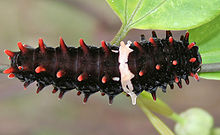 Caterpillar in Hyderabad, India
Caterpillar in Hyderabad, India
The caterpillar is a beautiful velvety maroon colour and has a beautiful white band on a segment on its middle reminiscent of a belt or collar. It has numerous fleshy red-tipped white protuberances on the body. It is bulky and slow in its movements. It is a beautiful caterpillar.
Pupa
The pupa is brownish with various shades of brown and pink markings. It is attached to its support by the tail and held at an angle by a body band. The support is usually a stick. The distinguishing feature of the Common Rose pupa is the presence of large semi-circular projections on the back of the abdomen, thorax and head.
Foodplants
The larvae feed on creepers and climbers of the genus Aristolochia, Family Aristolochiaceae and they sequester toxins such as aristolochic acid in their bodies. This makes the adults toxic to vertebrate predators such as birds and reptiles.[2] However the Braconid wasps which parasitise the caterpillars have apparently co-evolved with the butterfly and are not affected by the toxins. Larval foodplants include:
- Aristolochia bracteolata
- Aristolochia indica
- Aristolochia tagala
- Aristolochiae griffithi
- Thottea siliquosa
Cited references
- ^ Bingham, C. T. 1907. Fauna of British India. Butterflies. Volume 2
- ^ Tian-Shung Wu, Yann-Lii Leu and Yu-Yi Chan (2000) Aristolochic Acids as a Defensive Substance for the Aristolochiaceous Plant-Feeding Swallowtail Butterfly, Pachliopta aristolochiae interpositus Journal of the Chinese Chemical Society 47:221-226 [1]
See also
- Lepidoptera
- Butterflies
- Papilionidae
- List of butterflies of India
- List of butterflies of India (Papilionidae)
References
- Collins, N.M. & Morris, M.G. (1985) Threatened Swallowtail Butterflies of the World. IUCN. ISBN 2-88032-603-6
- Evans, W.H. (1932) The Identification of Indian Butterflies. (2nd Ed), Bombay Natural History Society, Mumbai, India
- Gaonkar, Harish (1996) Butterflies of the Western Ghats, India (including Sri Lanka) - A Biodiversity Assessment of a threatened mountain system. Journal of the Bombay Natural History Society.
- Gay, Thomas; Kehimkar, Isaac & Punetha, J.C.(1992) Common Butterflies of India. WWF-India and Oxford University Press, Mumbai, India.
- Kunte, Krushnamegh (2005) Butterflies of Peninsular India. Universities Press.
- Wynter-Blyth, M.A. (1957) Butterflies of the Indian Region, Bombay Natural History Society, Mumbai, India.
External links
Categories:- Atrophaneura
- Fauna of Pakistan
- Butterflies of India
Wikimedia Foundation. 2010.


